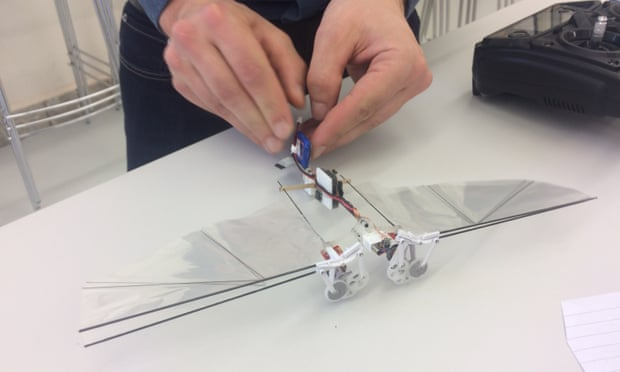But in Delft University of Technology in the Netherlands a group of scientists working on long-term solutions to some of the world’s thorniest problems have developed a solution that could have come straight from a sci-fi novel: robotic bees.
By reproducing some of the complex wing motion patterns and aerodynamics of fruit flies, in particular, researchers in the university’s newly opened Robohouse, a hub for Dutch expertise, believe they will be able to create swarms of bee-like drones to pollinate plants when the real-life insects have died away.
The wings of the robotic DelFly beat 17 times per second, to generate the lift needed to stay airborne and control its flight through small adjustments in their wing motion.
The researchers asked why a fly was so difficult to swat and looked to reproduce the insect’s evasive technique. The robo-bees can hover on the spot, fly in any direction, and even flip 360 degrees around pitch or roll axes. Because the robots’ wings are made of a lightweight film made of mylar, the material used in space blankets, it is safe for people to work around them.
The new drones, which can travel at up to 15mph, are also more efficient in their flight than those with helicopter-style blades, meaning their batteries can last longer. They can be fitted with spatial sensors so that they autonomously fly from plant to plant, avoiding each other and other obstacles as they go.
Previous attempts to perfect the technology in Harvard and elsewhere have produced useful models, but have proven to be too fragile or unable to navigate around each other.
Matěj Karásek, a researcher working on the project, said: “The use we see for this is pollination in green houses. The bee is under threat due to our farming methods and we don’t know what their future will be. This is one solution.”
“We are not trying to copy flies and bees, but we are trying to learn from them,” he said. “Physics limits how small normal drones can be.”
The robotic insect has a 33cm wingspan and weighs 29g, making it 55 times the size of a fruit fly. It can also only fly for six minutes, or 0.6 miles (1km) on its current battery. But the plan, the university says, is to reduce the size down to that of the insects they are trying to emulate as they develop the robot.
The Netherlands is one of the world’s largest exporters of agricultural and food products in the world. Bees are responsible for pollinating 80% of the edible crops grown in the country.
Yet of the 360 different species of bee in the Netherlands, about half of them are threatened. Globally, the dramatically falling numbers of pollinators in recent years has been blamed, in part, on the widespread use of pesticides.
It has been recently been claimed that one popular pesticide could wipe out common bumblebee populations by preventing the formation of new colonies.
The chemical, thiamethoxam, is said to dramatically reduces egg-laying by queen bumblebees. Predictions based on a mathematical model have suggested that this could result in the total collapse of local populations of the wild bees. In April the EU announced a ban would come in by the end of 2018 restricting their use to closed greenhouses.
Karásek told the Guardian: “I think within five to 10 years we will have the technology to make the drones much smaller and we could see them put to use in greenhouses.”
The developers are working to find a commercial partner for the project. Delft university’s Robohouse, opened six weeks ago, has been established to bring the country’s brightest engineering minds together with the private sector.
More about:
















































